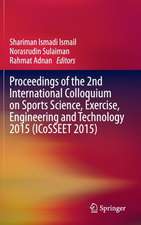Fluorescent Materials for Cell Imaging
Editat de Fu-Gen Wuen Limba Engleză Paperback – 26 oct 2021
| Toate formatele și edițiile | Preț | Express |
|---|---|---|
| Paperback (1) | 1284.80 lei 6-8 săpt. | |
| Springer Nature Singapore – 26 oct 2021 | 1284.80 lei 6-8 săpt. | |
| Hardback (1) | 1293.39 lei 6-8 săpt. | |
| Springer Nature Singapore – 26 oct 2020 | 1293.39 lei 6-8 săpt. |
Preț: 1284.80 lei
Preț vechi: 1352.42 lei
-5% Nou
Puncte Express: 1927
Preț estimativ în valută:
245.87€ • 266.99$ • 206.54£
245.87€ • 266.99$ • 206.54£
Carte tipărită la comandă
Livrare economică 23 aprilie-07 mai
Preluare comenzi: 021 569.72.76
Specificații
ISBN-13: 9789811550645
ISBN-10: 9811550646
Ilustrații: V, 247 p. 140 illus., 128 illus. in color.
Dimensiuni: 178 x 254 mm
Greutate: 0.45 kg
Ediția:1st ed. 2020
Editura: Springer Nature Singapore
Colecția Springer
Locul publicării:Singapore, Singapore
ISBN-10: 9811550646
Ilustrații: V, 247 p. 140 illus., 128 illus. in color.
Dimensiuni: 178 x 254 mm
Greutate: 0.45 kg
Ediția:1st ed. 2020
Editura: Springer Nature Singapore
Colecția Springer
Locul publicării:Singapore, Singapore
Cuprins
Chapter 1: Introduction: Fluorescent materials for cell imaging.- Chapter 2: Semiconductor quantum dots for cell imaging.- Chapter 3: Carbon nanodots for cell imaging.- Chapter 4: Silicon nanoparticles for cell imaging.- Chapter 5: Fluorescent metal nanoclusters for bioimaging.- Chapter 6: Lanthanide-based upconversion nanoparticles for bioimaging applications.- Chapter 7: Conjugated polymers and polymer dots for cell imaging.- Chapter 8: Aggregation-induced emission (AIE) probes for cell imaging.- Chapter 9: Luminescent coordination compounds for cell imaging.
Notă biografică
Dr. Fu-Gen Wu is a Professor of Biomedical Engineering at Southeast University. He received his BS and Ph.D. degrees from Tsinghua University in 2006 and 2011, respectively, and then completed his postdoctoral research at the University of Michigan-Ann Arbor from 2011 to 2013. In early 2013, he joined the faculty of the School of Biological Science and Medical Engineering of Southeast University, and was promoted to Full Professor in the same year. His main research interests are cell imaging, biomaterials and nanomedicine.
Textul de pe ultima copertă
This book focuses on the latest fluorescent materials for cell imaging. Cell imaging is a widely used basic technique that helps scientists gain a better understanding of biological functions through studies of cellular structure and dynamics. In the past decades, the development of a variety of new fluorescent materials has significantly extended the applications of cellular imaging techniques. This book presents recently developed fluorescent materials, including semiconductor quantum dots, carbon dots, silicon nanoparticles, metal nanoclusters, upconversion nanoparticles, conjugated polymers/polymer dots, aggregation-induced emission (AIE) probes, and coordination compounds, used for various cellular imaging purposes. It will appeal to cell biologists and other researchers in academia, industry and clinical settings who are interested in the technical development and advanced applications of fluorescence imaging in cells, tissues and organisms to explore the mechanisms of biological functions and diseases.
Caracteristici
Summarizes the applications of the recently developed fluorescent materials for cell imaging
Focuses mostly on non-commercially available fluorescent probes
Provides the state-of-the-art fundamental knowledge and applications of cellular imaging techniques from the material viewpoints
Focuses mostly on non-commercially available fluorescent probes
Provides the state-of-the-art fundamental knowledge and applications of cellular imaging techniques from the material viewpoints





















